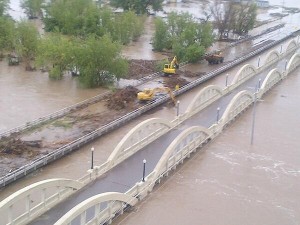 Our state has faced flood disaster before. Leaders in 1965 solved their problem expeditiously.
Our state has faced flood disaster before. Leaders in 1965 solved their problem expeditiously.
- A special session raised taxes – for a 13-month period – to pay for highway restoration projects.
- Local projects shared in the revenues.
- They suggested legislation to handle (and mitigate) future disasters.
- They considered private sector needs in addition to state and local government projects.
Names that still echo in today’s Colorado abound in that disaster response, leaders worthy of emulation. Reading their report is a helpful lesson in legislative restraint.
One thing is clear. Colorado cannot dawdle. What to do is obvious.
Our legislature appropriated a billion dollar reserve to education without requiring outcome improvements in our state’s schools. That money should be reappropriated in special session to disaster response.
If those dollars are not adequate, our state constitution’s TABOR section authorizes “emergency taxes” that are passed by 2/3rds of the General Assembly and subsequently approved by Colorado voters. Such taxes, if truly needed, should be neither permanent nor aimed at extraneous, ancillary porkbarrel spending.
One specific Colorado problem jumps out of the 1965 report: the Narrows on the Big Thompson just west of Loveland – the route of US 34.
Three flood disasters in the same location (’65, ’76, ’13) in fifty years prove it’s time to quit half measures for the Narrows.
The highway must be moved up and out of the canyon. Federal highway rebuilding money should made available to move the road out of the canyon. Instead, build a flood control dam in the Narrows to protect Greeley and Northeast Colorado. Colorado must find the money to mitigate future flooding.

Unless it's written into the law that they expire by DATE YEAR. Right?
The only problem with an emergency tax increase, you can't trust Democrats to roll it back when the matter is solved. And they're in charge.
I also remember the 65 flood. My friend lost a cousin. I remember how it rained and rained and then on the day the sun finally showed its face was the day the water hit. I was 10.
I lived in the newer Cottonwood area of Parker. You can still see the scars from the flood when driving on 83 towards the Town of Parker. There has been so much building going on around Arapaho and Parker Rd. Does anyone know how the houses fared on Jordon Rd and Bronco Blvd? That was a major flood plane and I wonder how all the boulders worked. That is why the only structures that are near the creek should be recreational.
1965 was the worst. I saw it first hand as it rolled a mile across with a 20 ft. crest down the valley where the dam is now. Chatfield Dam was built in 1967 to make sure it never happened again. This isn't June. It's almost October and the snow is coming. We must act now.